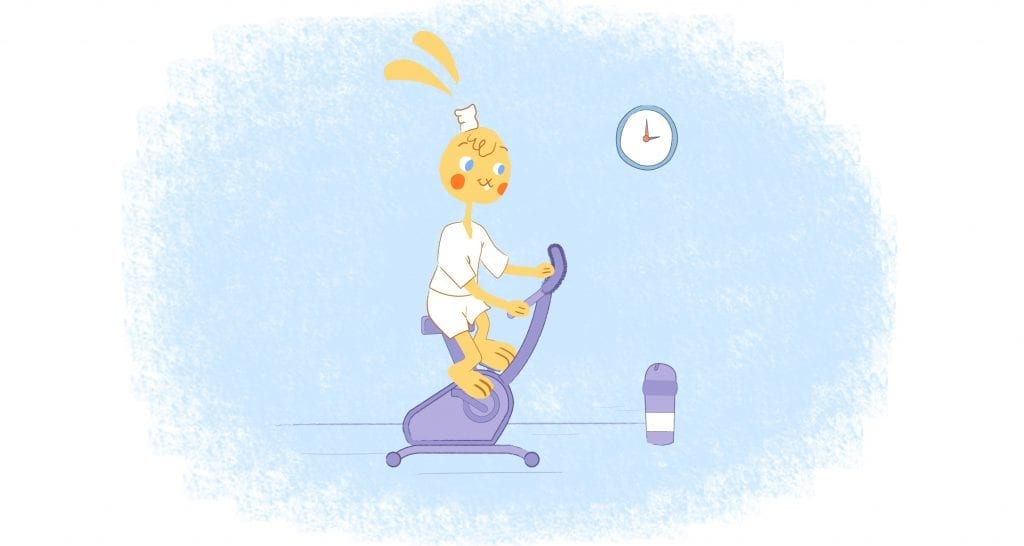

Traditionally, you manage your time by dividing tasks and assigning specific amounts of time to each task. A good example is setting a two-hour deadline for yourself to complete three reports.
Energy, however, is not taken into account by this method. It could be partly due to the obsession over time management that 52% of employees feel burnt out.
Unlike time, energy does not have a finite supply.
The renewable nature of energy is limited, but it can still be utilized for a long time. For example, it may seem like a good idea to schedule every minute of free time so you can increase productivity. But you don’t account for the need to replenish your energy supply.
What’s more, the energy needed for some tasks varies as well. If you’re already overloaded with daily commitments, high-energy tasks and multitasking can’t be done effectively.
Overall, it is possible to become less productive over time, even when you have more than enough time to complete your tasks. And this is especially true when you work from home.
With that in mind, here’s how you can effectively manage your energy when working from home.
1. Identify the best time for managing your energy.
Generally, people cannot keep up their energy levels for an 8-hour day — regardless of how many energy drinks you throw back. So you should work out when you’re at your most energetic.
With that in mind, determine when you’re most productive. For some, that would be in the AM. Others, however, may be more productive in the afternoon. It really depends on your ultradian rhythms. This is your natural rhythm when responding to stimulation all day long. Basically, it’s how your body manages energy and does its best to survive.
So, for example, if you wake up full of energy and creative ideas, set aside time for brainstorming, strategy sessions, and proposal writing in the morning. Then, later in the afternoon, when your energy is low, you can work on lighter, more repetitive tasks that won’t drain your energy.
2. Establish regular deep work hours in your daily schedule.
“If you’re always being forced to make decisions about simple tasks — when should I work out, where do I go to write, when do I pay the bills — then you have less time for freedom,” writes James Clear in his bestselling books Atomic Habits. “It’s only by making the fundamentals of life easier that you can create the mental space needed for free-thinking and creativity.”
Working on your most essential tasks simultaneously eliminates the energy-sucking decision-making process regarding what to work on. In other words, set regular deep work hours instead of deciding where to place that chunk of work. Additionally, this scheduling process allows you to bypass tasks that aren’t vital to achieving your goals.
By advocating for your energy levels, you can perform at your best. Why? The more you say no to non-essential tasks, the more energy you have to do the valuable work that matters most.
If you work remotely, you may underestimate what you can accomplish in a day. To resolve this issue, you need to acknowledge it is a problem and remind yourself that doing quality work takes energy.
Over time, setting boundaries, taking frequent breaks, and maintaining a good pace will lead to better work results. But, of course, that’s what everyone wants.
3. Make the rule of 3 work for you.
“First off, stop trying to do everything in one day,” Choncé Maddox writes in a previous Calendar article. “I suffer from procrastination, and it’s often a result of overloading my daily schedule.” And, when you commit to too much, you’ve punched your ticket to Burnoutville.
“Instead of doing this, pick your most important three things you want to accomplish for the day,” she suggests. “Then, rank your #1 task.” Once you complete it, you’ll be able to feel accomplished no matter what the day brings. You may need to do smaller tasks some days to preserve your energy. “You may think that limiting what you can do in a day would make you more overwhelmed in the future when work piles up.”
“On the contrary, using the rule of 3 will help you really narrow down your priorities and start to let some other things go,” Choncé explains. “I like to write down all the tasks I have for the week on a whiteboard and divvy up the list throughout the week.”
“Sometimes the whole list doesn’t get taken care of, and I don’t waste my energy on it,” she says. “Instead, I take comfort in knowing I focused on the top-level tasks that will help me keep making progress each week.”
4. Define boundaries.
There tends to be a blurring of the lines between your personal and professional lives when you work from home.
For example, attending a virtual meeting while doing laundry or getting the kids to bed. Sure, you may find this degree of freedom a great luxury. Or, on the flip side, it’s not too great responding to work emails when you’re having dinner with friends. But, eventually, blurring lines may hurt your home and work lives.
To deal with this issue, create clear boundaries between your private and professional lives.
Moreover, you should not do that just for yourself. It would help if you also considered your family members and team members. As a result, you’ll ensure you enjoy a healthy work-life balance from day one.
Let’s take a look at a few examples.
Personal Boundaries
When working from home, you need to set rules, such as:
- You should always work in your designated workspace.
- Identify your working hours. And actively avoid working long hours on a regular basis.
- While at work, refrain from taking care of any personal commitments.
- Ensure you take full responsibility for what you do without causing delays.
Team Boundaries
Here are the rules that will guide your engagement with your team:
- First, ensure your team knows your work hours and that you will turn off work notifications after those hours.
- Inform them politely that you will no longer receive work-related phone calls after work hours.
Boundaries with Family Members
When you work from home, your loved ones or roommates can be a big distraction.
You can minimize these distractions by following these steps:
- Request that your family does not disturb you during your work hours. Sharing your calendar with them is probably the easiest way to do this.
- Synchronize your calendars if you have other family members working from home.
- It is essential to inform your housemates about your meeting times — particularly if you have children at home. This way, your virtual meeting won’t get hijacked by your kids.
5. Make sure that your WFH setup is respected.
As I mentioned previously, working from home can make it challenging to separate work and home. Many people work from home specifically to avoid choosing between these two options. In light of this, you must treat your home office to minimize stress and maintain energy levels. In addition, if we’re going back to boundaries, make sure other household members follow your example as well.
Your energy is sapped whenever you are constantly emotionally tied to a situation. The same is true when you have a cluttered office or don’t have a clear focus in your space.
Consequently, these factors can make it difficult to focus on your work.
6. Put your health first.
If there is one knock against working remotely, it can lead to a sedentary lifestyle. Suffice it to say; that if you overlook your health, your energy levels will plummet.
In terms of your physical health, everyone should address three basic areas:
- Sleep. Ideally, it would help if you slept seven to eight hours per night. However, it is also essential to ensure that your sleeping environment is conducive to good sleep.
- Diet. You should develop a diet that keeps your body fueled throughout the day and is tailored to your needs.
- Exercise. It is possible for someone who works at home to become lethargic due to sitting all day. You can keep your body in shape by doing anything from a home gym to a good “deskercise” routine. Or, at the minimum, set calendar reminders to get up and stretch.
Aside from these primary health considerations, it’s also wise to watch out for medical issues. For instance, a chiropractor can help you if you suffer chronic backaches from sitting at a desk for an extended period of time. In addition, to manage your acid reflux symptoms while you work, you may want to consider using a good GERD medication.
You should also regularly address your mental health needs in addition to your physical health. For example, studies have shown that young workers are more stressed and anxious since they are required to work remotely. Here are some suggestions for keeping your mental health in mind:
- Taking strategic breaks throughout the day.
- Upgrading your home office — even if it’s just introducing plans.
- Taking short walks outside.
- Wearing clothes that make you “happy.”
- Scheduling non-work activities that you enjoy.
- Speaking with a trusted mental health professional.
7. Schedule regular check-ins.
Another common drawback to working remotely, in addition to the sedentary lifestyle, is feeling isolated. In fact, according to a study, 81% of under-35s fear loneliness when working at home long-term.
To prevent feeling lonely or isolated, schedule regular check-ins in your calendar. One idea would be a weekly virtual lunch with a co-worker. Another could be working twice a week in a coworking space. And you could also start a Slack channel for daily interaction.
At the same time, you don’t have to only engage with your colleagues or your fellow WFH compadres. You can also make plans with friends or family during your downtime.
8. Pay attention to your fuel light.
I don’t want to speak on behalf of you, who work from home. But, there probably was a time when you noticed your fuel light illuminate while driving. So, you decide to go full Kramer from Seinfeld to see how far you can go — until you can’t.
When I was younger, I did this a time or two. It might be exhilarating at first. Then, however, when your car begins to sputter, a whole wave of anxiety washes over you.
Similar results can be expected if you ignore your internal fuel light.
When it comes to managing your energy levels, your body is your only meter. So, even if you stick to your schedule, you can’t ignore what your body is telling you. It’s natural for our bodies to let us know what they need. So, whether you are hungry or tired, you are both.
The body sometimes gets it wrong, like when you crave one more slice of pizza. But generally speaking, these bodies are pretty reliable. Simply put, your body will tell you if you need a break when you’re feeling fatigued.
9. Be flexible.
Performing a task that doesn’t fit your current state of mind is a waste of time and counterproductive.
As such, you should internalize the idea that feeling low energy and slowing down isn’t a sign of laziness. Again, throughout the day, our bodies’ ultradian cycles affect our energy levels.
Instead of pushing through, take a break and recharge. There is no point in blocking time to work on that presentation or article if you do not have the energy to do it.
But, at this point, I think you understand this.
The solution, in addition to taking breaks, is to leave some free space in your calendar. This is nothing more than a block of time in your calendar where nothing is scheduled. It doesn’t have too much, maybe 30-minutes or an hour.
Leaving this white space in your calendar allows you to shift your day accordingly. For example, if you don’t have the energy to tackle your most important task in the morning because you had a crying baby at night, you can dive into this later in the day when you feel more energetic.
Image Credit: Vlada Karpovich; Pexels; Thank you!











Deanna Ritchie
Editor-in-Chief at Calendar. Former Editor-in-Chief and writer at Startup Grind. Freelance editor at Entrepreneur.com. Deanna loves to help build startups, and guide them to discover the business value of their online content and social media marketing.